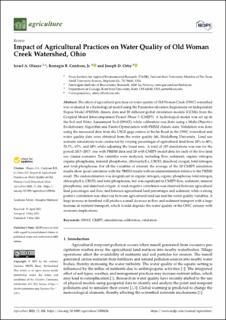| dc.description.abstract | The effect of agricultural practices on water quality of Old Woman Creek (OWC) watershed was evaluated in a hydrological model using the Parameter-elevation Regressions on Independent Slopes Model (PRISM) climate data and 20 different global circulation models (GCMs) from the Coupled Model Intercomparison Project Phase 5 (CMIP5). A hydrological model was set up in the Soil and Water Assessment Tool (SWAT), while calibration was done using a Multi-Objective Evolutionary Algorithm and Pareto Optimization with PRISM climate data. Validation was done using the measured data from the USGS gage station at Berlin Road in the OWC watershed and water quality data were obtained from the water quality lab, Heidelberg University. Land use scenario simulations were conducted by varying percentages of agricultural land from 20% to 40%, 53.5%, 65%, and 80% while adjusting the forest area. A total of 105 simulations was run for the period 2015–2017: one with PRISM data and 20 with CMIP5 model data for each of the five land use classes scenarios. Ten variables were analyzed, including flow, sediment, organic nitrogen, organic phosphorus, mineral phosphorus, chlorophyll a, CBOD, dissolved oxygen, total nitrogen, and total phosphorus. For all the variables of interest, the average of the 20 CMIP5 simulation results show good correlation with the PRISM results with an underestimation relative to the PRISM result. The underestimation was insignificant in organic nitrogen, organic phosphorus, total nitrogen, chlorophyll a, CBOD, and total phosphorus, but was significant in CMIP5 flow, sediment, mineral phosphorus, and dissolved oxygen. A weak negative correlation was observed between agricultural land percentages and flow, and between agricultural land percentages and sediment, while a strong positive correlation was observed between agricultural land use and the water quality variables. A large increase in farmland will produce a small decrease in flow and sediment transport with a large increase in nutrient transport, which would degrade the water quality of the OWC estuary with economic implications. | en_US |

